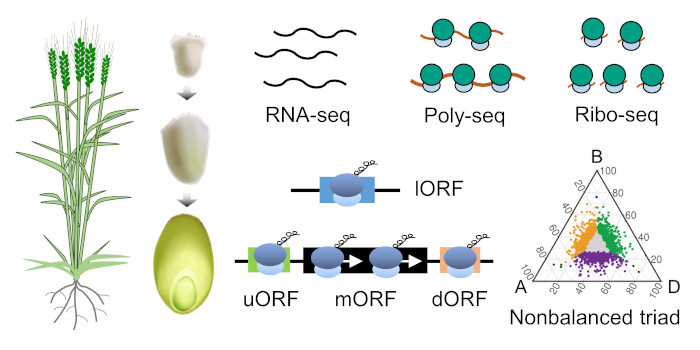Wheat Grain Research Goes Translational Regulation
By Yiwen Guo, Yongming Chen, and Huiru Peng
Frontiers Science Center for Molecular Design Breeding, Key Laboratory of Crop Heterosis and Utilization, Beijing Key Laboratory of Crop Genetic Improvement, China Agricultural University, Beijing 100193, China.
Background: Bread wheat (Triticum aestivum) is one of the most widely cultivated cereal crops worldwide and provides most of the calories consumed by humans. DNA contains the genetic codes and is first transcribed to produce mRNAs, which are then translated to produce proteins. Translational regulation is a widespread mechanism that rapidly modulates gene expression to maintain growth and development. The current investigations into gene regulation in wheat grains focus on the transcriptional level, neglecting the translational level.
Question: How is gene expression regulated at the translational level in developing wheat grains? What functional proteins are involved in grain development?
Findings: We used two approaches, namely ribosome profiling and polysome profiling, to obtain a unique translatome dataset of developing bread wheat grain. The translation of many functional genes is modulated in a stage-specific manner. The divergence of the translational regulation between the wheat subgenomes is pervasive, which increases the expression flexibility of allohexaploid wheat. Widespread, previously unannotated open reading frames (ORFs) are actively expressed in wheat grains. Upstream open reading frames (uORFs) as translational regulatory elements can repress or even activate the translation of mRNAs. Gene translation may be combinatorially modulated by uORFs, downstream ORFs, and microRNAs.
 Next steps: Our work presents valuable translatomic resources for understanding the translational control of gene expression during wheat grain development. Further studies will explore functional translational regulatory elements to improve wheat yield and quality.
Next steps: Our work presents valuable translatomic resources for understanding the translational control of gene expression during wheat grain development. Further studies will explore functional translational regulatory elements to improve wheat yield and quality.
Reference:
Yiwen Guo, Yongming Chen, Yongfa Wang, Xiaojia Wu, Xiaoyu Zhang, Weiwei Mao, Hongjian Yu, Kai Guo, Jin Xu, Liang Ma, Weilong Guo, Zhaorong Hu, Mingming Xin, Yingyin Yao, Zhongfu Ni, Qixin Sun, and Huiru Peng. (2023). The translational landscape of bread wheat during grain development. https://doi.org/10.1093/plcell/koad075
题目:小麦籽粒发育的翻译调控图谱
Guo、Chen和Peng等人在The Plant Cell在线发表了题为“The translational landscape of bread wheat during grain development”的研究论文,构建了小麦籽粒发育的翻译组图谱,揭示了籽粒发育过程的翻译调控机制。
背景回顾:
小麦是世界范围内最重要的谷类作物之一,为人类提供了所需的能量和蛋白质。遗传信息首先转录产生mRNA,然后翻译产生蛋白质。在小麦的生长发育过程中,翻译水平上的基因表达调控发挥着重要作用。然而,当前对小麦籽粒的研究主要集中在转录水平,对翻译调控了解甚少。
科学问题:
在小麦籽粒发育过程中,基因表达在翻译水平是如何被调控的?哪些功能蛋白参与了籽粒发育过程的翻译调控?
研究发现:
该研究利用核糖体谱和多聚核糖体谱分析技术构建了小麦籽粒发育的翻译组图谱。发现许多功能基因的表达在不同籽粒发育阶段被特异地翻译调控。小麦亚基因组间部分同源基因的翻译调控发生分化,从而提高了异源六倍体小麦的表达可塑性。此外,研究发现小麦籽粒中存在许多未知的开放阅读框(ORF)。上游ORF(uORF)可以抑制甚至增强基因的翻译,扮演着翻译调控元件的角色。基因翻译可能受到uORF、下游ORF和microRNA的共同调控。
展望未来:
该研究构建了小麦籽粒翻译调控图谱,加深了对籽粒发育过程中翻译水平上基因表达调控的认识。未来的研究将对翻译调控元件进行更多的功能分析,并将其应用于小麦品种改良。





